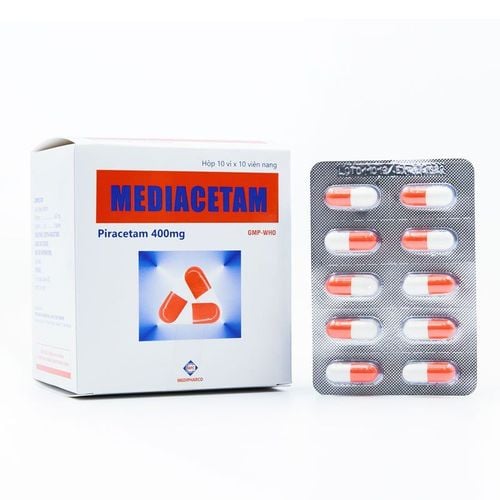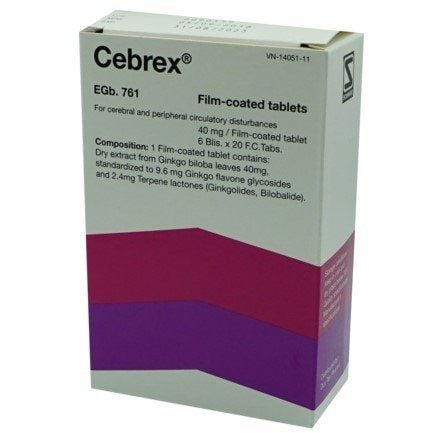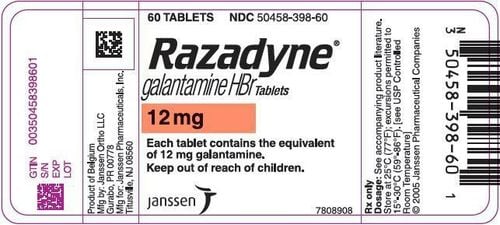This is an automatically translated article.
Stacetam medicine 400mg with the main active ingredient is Piracetam, used in the treatment of symptoms of dizziness, cerebral ischemia, difficulty speaking in children and sickle cell anemia. The following article provides you with information about the uses and uses of Stacetam.
1. What does Stacetam 400mg do?
Stacetam contains the main ingredient Piracetam, the drug is prepared in the form of film-coated tablets with a content of 400mg.Piracetam (cyclic derivative of gamma aminobutyric acid, GABA) is considered a stimulant (helps to improve nerve cell metabolism and the ability to learn and memory). Piracetam acts directly on the brain, increasing the activity of the cerebral cortex (the area of the brain involved in cognition, memory, learning, alertness and consciousness).
Piracetam acts on neurotransmitters such as Noradrenalin, Acetylcholine, Dopamine.
Piracetam can change neurotransmitters, contributing to improving the metabolic environment for nerve cells to function properly. Piracetam increases glucose mobilization and utilization independent of oxygen supply, which facilitates the pentose pathway and maintains energy synthesis in the brain.
Piracetam enhances recovery rates from hypoxic injury by reducing glucose and lactic acid accumulation and increasing the turnover of inorganic phosphates. Under normal and hypoxic conditions, Piracetam increases the conversion of ADP to ATP thereby increasing the amount of ATP in the brain. Piracetam has no sedating, analgesia, revitalizing, neuroleptic or sedative effects, and it does not have the effects of GABA.
Piracetam reduces platelet aggregation. In the case of abnormally stiff red blood cells, Piracetam can help red blood cells recover their deformability and ability to pass through capillaries. Besides, Piracetam has anti-muscle tremor effect. Research data suggest that the underlying mechanism of action of Piracetam is neither cell nor organ specific. Piracetam physically binds to the phospholipid terminal in the cell membrane model in a dose-dependent manner, which results in restoration of the lamellar membrane structure characterized by the formation of a mobile drug-phospholipid complex. This leads to improved membrane stability, allowing transmembrane and transmembrane proteins to maintain or restore their three-dimensional or folded structure to perform its function. Piracetam also has effects on nerves and blood vessels.
2. Indications and contraindications of Stacetam 400mg
Stacetam is indicated in the following cases:
Symptomatic treatment of dizziness. Elderly: Memory impairment, poor concentration, dizziness, or lack of alertness, behavioral disturbances, poor attention to self, mood changes, dementia due to multifocal cerebral infarction. Acute ischemic stroke. It is important to pay attention to the patient's age and the initial severity of stroke, which are the most important factors for predicting survival after stroke. Treatment of alcoholism. Treatment of sickle cell anemia (Piracetam has the effect of inhibiting and restoring sickle cells and has a good effect on patients with sickle cell anemia). Supportive treatment of dyslexia in children. Aids in the treatment of myoclonic jerks of cortical origin. Stacetam is contraindicated in the following cases:
Allergy or hypersensitivity to Piracetam or any of its ingredients. Severe renal impairment (creatinine clearance < 20 ml/min). Severe liver failure. Patients with Huntington's disease. Brain hemorrhage.
3. How to take Stacetam 400mg
Stacetam film-coated tablets are taken orally, divided equally into 2 times a day or 3-4 times.
Swallow the tablet completely with water without breaking or chewing it because Piracetam has a bitter taste.
Stacetam usual dose: 30 - 160mg/kg/day, depending on indications.
Long-term treatment of psychosomatic syndromes in the elderly: 1.2 - 2.4g/day, depending on each patient. The dose may be as high as 4.8g/day during the first few weeks.
Treatment of alcoholism: 12g/day during the first period of alcohol withdrawal. Maintenance dose: 2.4g/day.
Cognitive decline after brain injury (with or without dizziness): the initial dose is 9-12g/day. The maintenance dose is 2.4g/day, taken for at least three weeks.
Sickle cell anemia: 160mg/kg/day, equally divided dose into 4 times/day.
Treatment of myoclonus: 7.2g/day, divided equally into 2-3 times/day. Depending on the patient's response, once every 3 to 4 days, the dose may be increased by 4.8 g/day up to a maximum dose of 20 g/day. Once the optimal therapeutic dose of Piracetam for the patient has been achieved, the dose of the combination drugs should be reduced.
Stacetam should not be used in children under 16 years of age.
Overdosage of Stacetam and treatment:
To date, toxicity of Piracetam has not been recorded even at very high doses. It is not necessary to take special measures in the event of an overdose of Stacetam. If symptoms of overdose occur, it is mainly supportive and symptomatic treatment, there is no specific treatment for Stacetam. Missing a dose of Stacetam and what to do:
If you forget to take a dose of Stacetam, take it as soon as possible. If it is almost time for your next dose of Stacetam, skip the missed dose and take your next dose as scheduled. Also, do not double the dose of Stacetam.
4. Undesirable effects when using Dasoltac drug
When using Dasoltac, you may experience some of the following undesirable effects:
Fatigue. Nausea, vomiting, diarrhea, pain and bloating. Restlessness, headache, excitability, insomnia, somnolence. Dizzy. Aphrodisiac, tremor. Stacetam side effects can be mitigated by reducing the dose. During the use of Stacetam, if any undesirable effects appear, notify the doctor for timely treatment.
5. Some notes when using Stacetam
Piracetam is excreted by the kidneys, the increased half-life of the drug is directly related to the creatinine clearance and the degree of renal impairment. Use caution when administering Stacetam to patients with renal impairment. Monitor renal function in these patients and caution in elderly patients.
Creatinine clearance < 60 ml/min or serum creatinine > 1.25 mg/100 ml, dose adjustment is required:
Creatinine clearance 60 - 4 ml/min, serum creatinine 1.25 - 1.7 mg /100ml (half-life of Piracetam doubled): the dose is 1/2 the normal dose. Creatinine clearance 40-20ml/min, serum creatinine 1.7-3.0mg/100ml (half-life of Piracetam is about 25-42 hours): the dose is 1/4 of the normal dose. Stacetam preparations contain approximately 23 mg of sodium per dose, which should be considered when administering the drug to patients on salt abstention.
Patients with peptic ulcer, history of hemorrhagic stroke in the brain, taking bleeding drugs increase the risk of bleeding, caution in major surgery due to the potential for coagulopathy.
Ability to drive and use machines: Do not drive or operate machinery while being treated with Stacetam.
Pregnant women: because Piracetam can cross the placenta. Stacetam should not be used by pregnant women.
Lactating women: Stacetam should not be used by women who are breastfeeding.
6. Drug interactions
There have been reports of interactions between Piracetam and thyroid hormone when used concurrently: Confusion and sleep disturbance, irritability. Warfarin: In patients whose prothrombin time has been stabilized, this index may be increased by concomitant administration of Stacetam and Warfarin. Coumarin anticoagulants: Concomitant administration of Piracetam reduces platelet aggregation, fibrinogen concentration and blood viscosity. Above is some information to share about the uses, doses and notes when using Stacetam. To ensure safety for your health and maximize the effectiveness of your treatment, you need to take Stacetam exactly as directed by your doctor.
Please dial HOTLINE for more information or register for an appointment HERE. Download MyVinmec app to make appointments faster and to manage your bookings easily.













